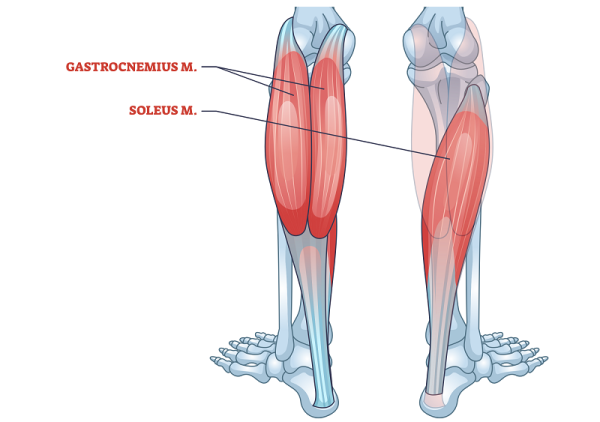Overview
The barbell seated calf raise is a lower leg isolation exercise that primarily targets the soleus muscle, located beneath the gastrocnemius in the calf. Because the knees remain flexed during the movement, the gastrocnemius is shortened and partially deactivated, placing most of the load on the soleus. This exercise is highly effective for increasing calf muscle mass, ankle joint strength, and postural stability, and is often used in bodybuilding, general strength training, and athletic rehabilitation.
How to Perform Barbell Seated Calf Raise

Setup: Sit on a flat bench with your feet shoulder-width apart on a raised surface or platform (2–4 inches high). Your knees should be bent at roughly 90 degrees.
Load the Barbell: Carefully place a padded barbell across your lower thighs, just above the kneecaps. Use a squat pad or towel for comfort.
Starting Position: Sit upright with a neutral spine, core braced, and toes pointing forward. Heels should be hanging off the edge of the platform.
Raise: Press through the balls of your feet and lift your heels as high as possible, contracting the calves at the top.
Pause and Contract: Hold the top position for 1–2 seconds to maximize soleus engagement.
Lower Slowly: Descend under control, allowing the heels to dip below the platform to stretch the calf.
Repeat: Complete the desired number of repetitions without bouncing or jerking.
Tips for Proper Form
Use a stable platform under your forefoot to allow full range of motion.
Keep your spine neutral and avoid leaning forward excessively during the lift.
Squeeze at the top of each rep to activate the soleus more effectively.
Lower your heels slowly to benefit from the eccentric portion of the movement.
Don’t roll your ankles — keep feet flat and stable through the range of motion.
Common Mistakes
Using too much weight, leading to reduced range of motion or bouncing.
Not using a platform, which shortens the range and limits the stretch at the bottom.
Skipping the pause at the top, which reduces time under tension.
Allowing the knees to move, which reduces stability and isolates the soleus less effectively.
Failing to control the eccentric phase, missing the opportunity for muscular growth.
Benefits of the Barbell Seated Calf Raise
Targets the soleus muscle: Emphasizes the deeper, endurance-oriented muscle of the calf that’s often undertrained.
Increases ankle plantarflexion strength: Enhances control and force production in movements like running and jumping.
Improves lower leg endurance: Especially valuable for long-duration standing, walking, or sports performance.
Supports posture and gait: A strong soleus contributes to upright posture and efficient walking patterns.
Promotes muscle balance: Balances development between the gastrocnemius and soleus, reducing risk of calf strains.
Effective for hypertrophy: High reps with slow tempo build visible calf thickness and volume.
Low equipment requirements: Requires only a barbell and bench, with optional blocks or plates as a platform.
How to Incorporate Into Your Routine
For Beginners: Start with bodyweight or an empty barbell for 2–3 sets of 12–15 reps to develop technique and ankle control.
For Hypertrophy: Perform 3–4 sets of 15–20 reps using moderate to heavy loads with a full pause at the top and a slow eccentric.
For Strength: Use 4–5 sets of 8–12 reps with progressive overload, focusing on consistent tempo and peak contraction.
For Functional Training: Add to rehab or injury-prevention circuits to reinforce ankle plantarflexion and calf balance.
For Endurance: Include 15–20 reps in a lower-body finisher circuit with limited rest for muscular endurance.
For General Fitness: Perform 2–3 sets of 12–15 reps weekly to improve ankle function and posture.
For Athletic Performance: Combine with standing calf raises and plyometric drills to improve sprint mechanics and explosive push-off.
Barbell Seated Calf Raise: Muscles Worked

Frequently Asked Questions
Why perform calf raises seated instead of standing?
Seated calf raises isolate the soleus muscle, while standing variations emphasize the gastrocnemius. Both are important for complete calf development.
How high should I raise my heels during the lift?
Aim to rise as high as possible onto your toes, pausing at the top. The greater the plantarflexion, the more effective the contraction.
What if I feel pain in the front of my ankle?
Check your platform height and ensure controlled movement. Excessive load or tight anterior ankle structures may require mobility work.
Can I substitute dumbbells or kettlebells instead of a barbell?
Yes. Placing dumbbells or a kettlebell on your thighs can mimic the barbell version, though balance may be more difficult.
How often should I train the soleus?
Since the soleus is highly fatigue-resistant, it can be trained 2–4 times per week, especially with high-volume protocols.
